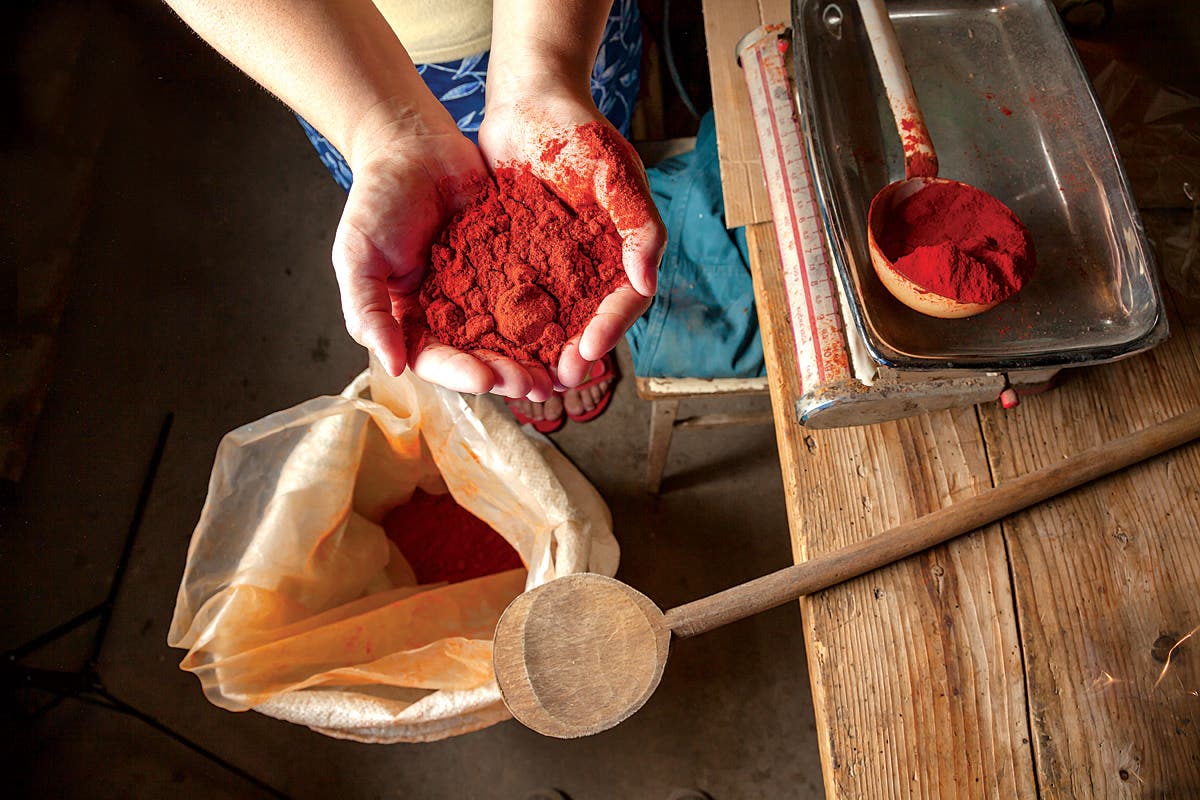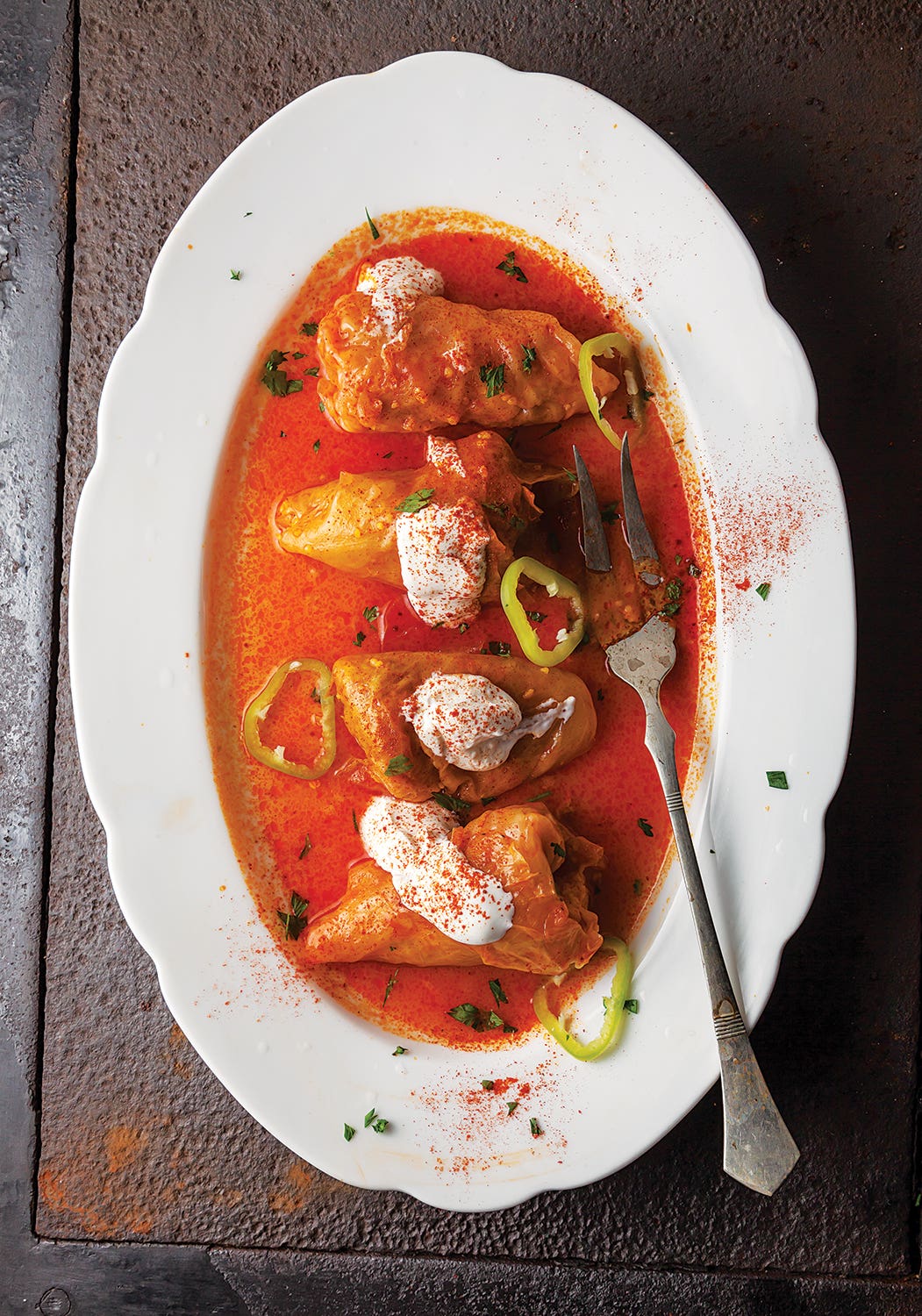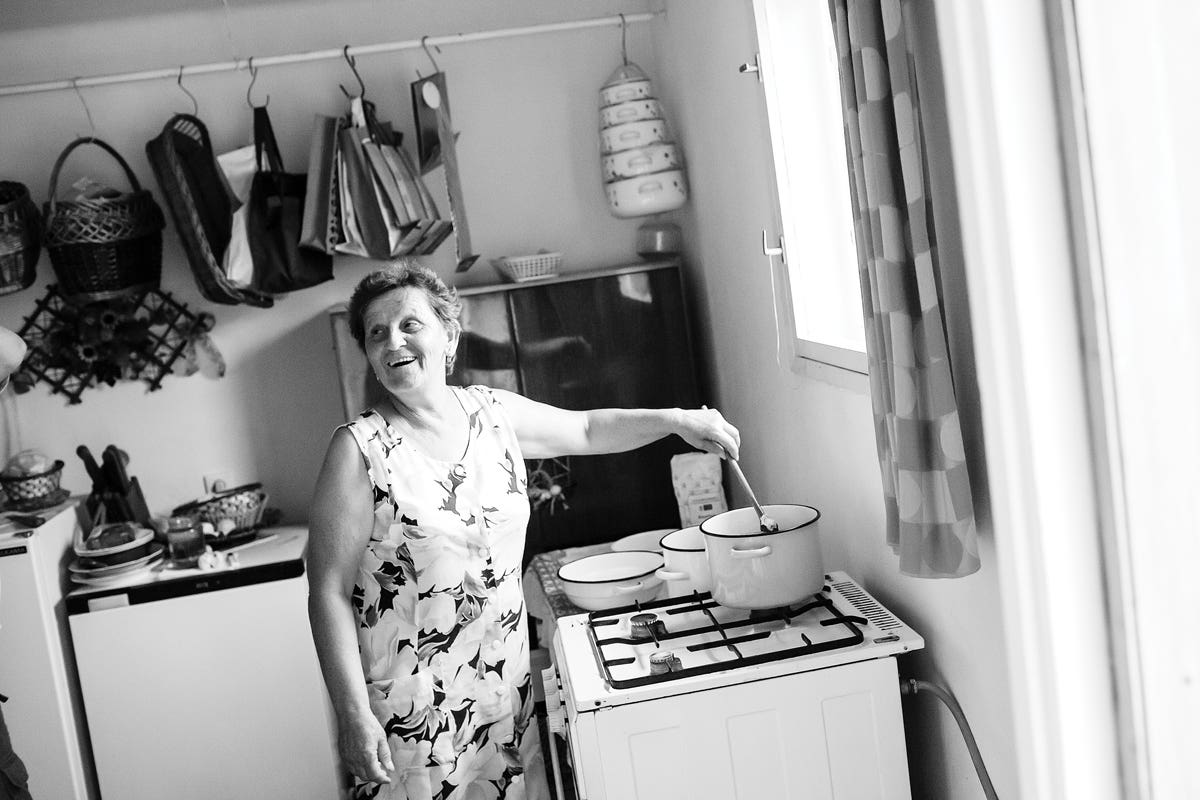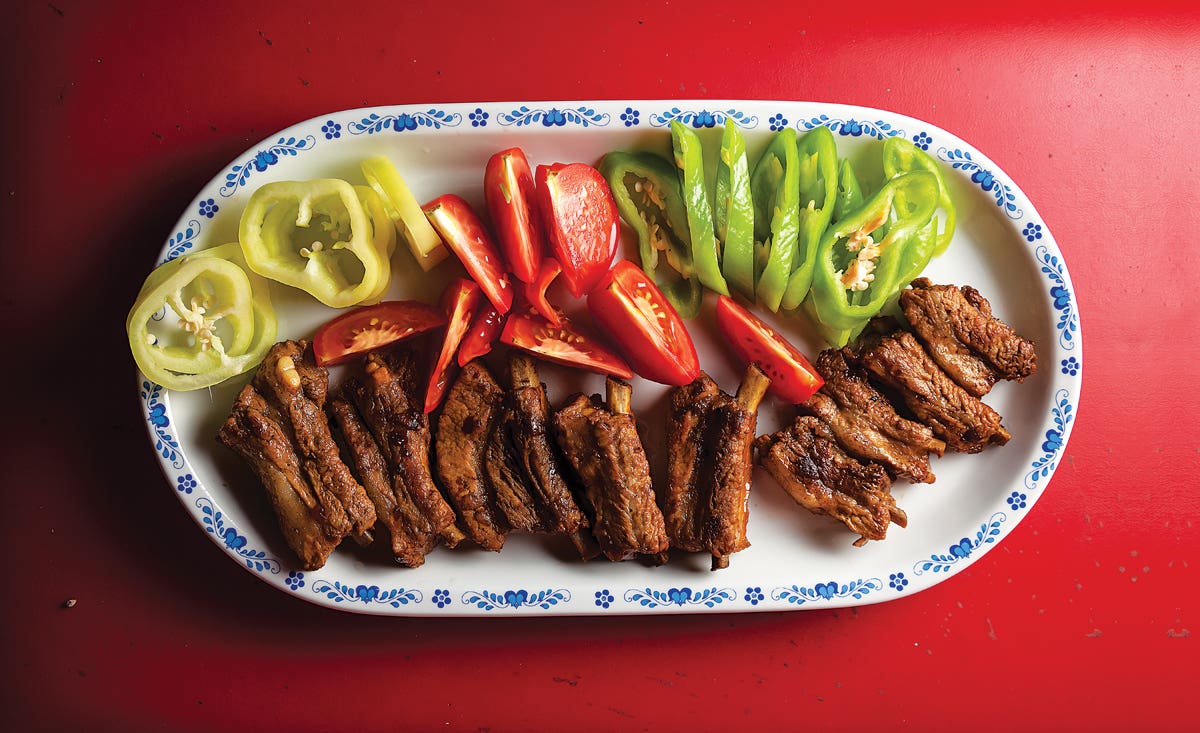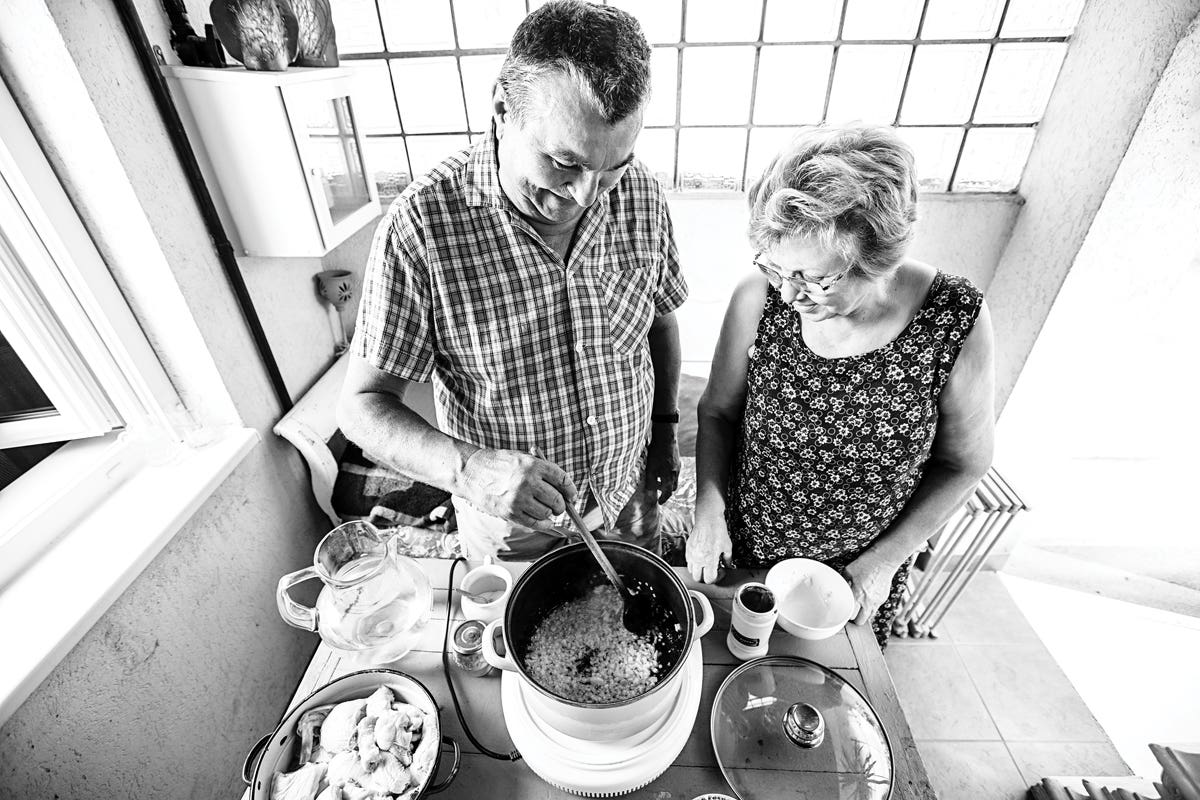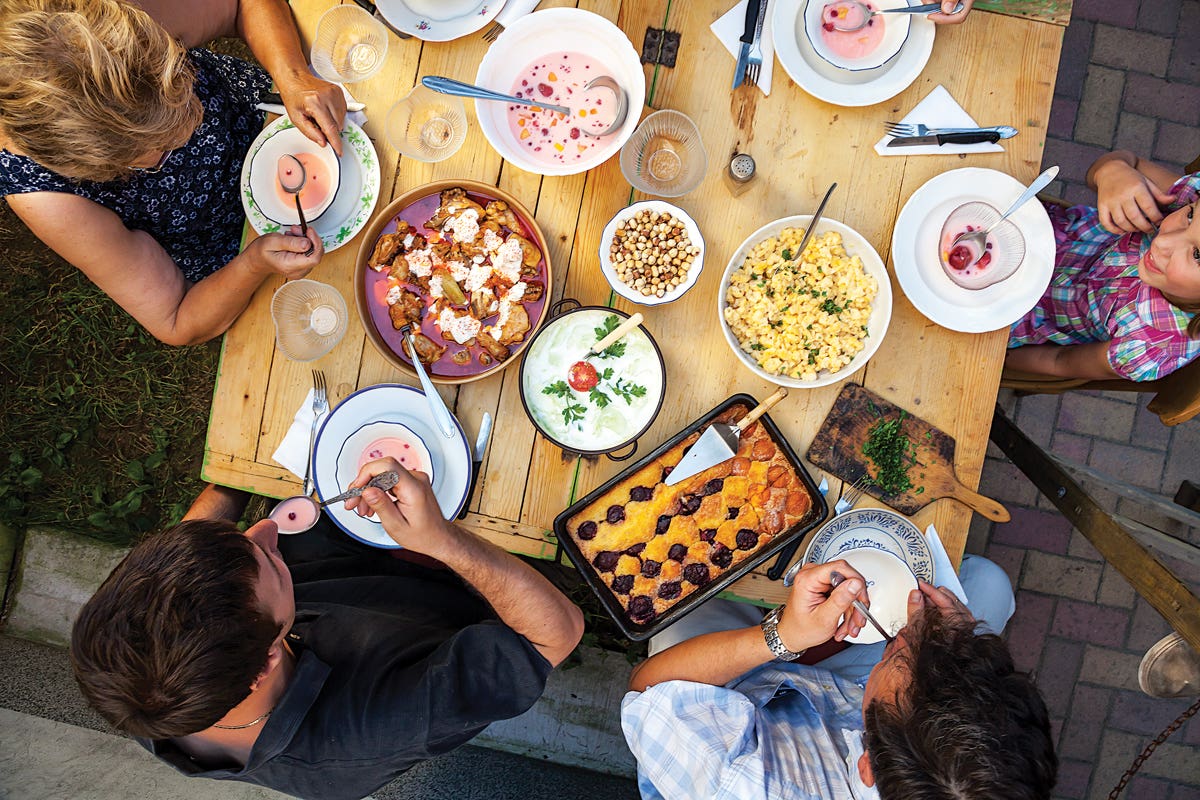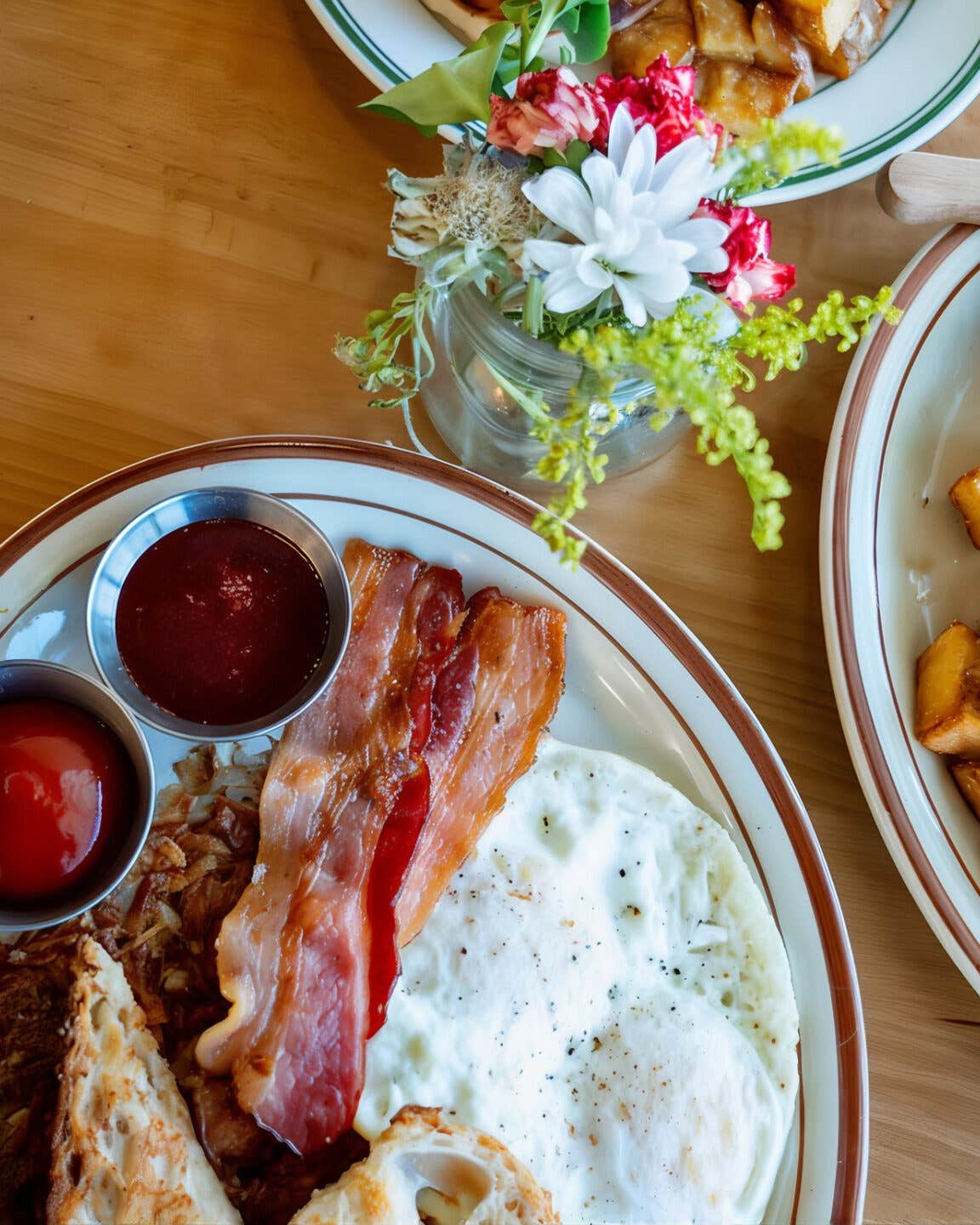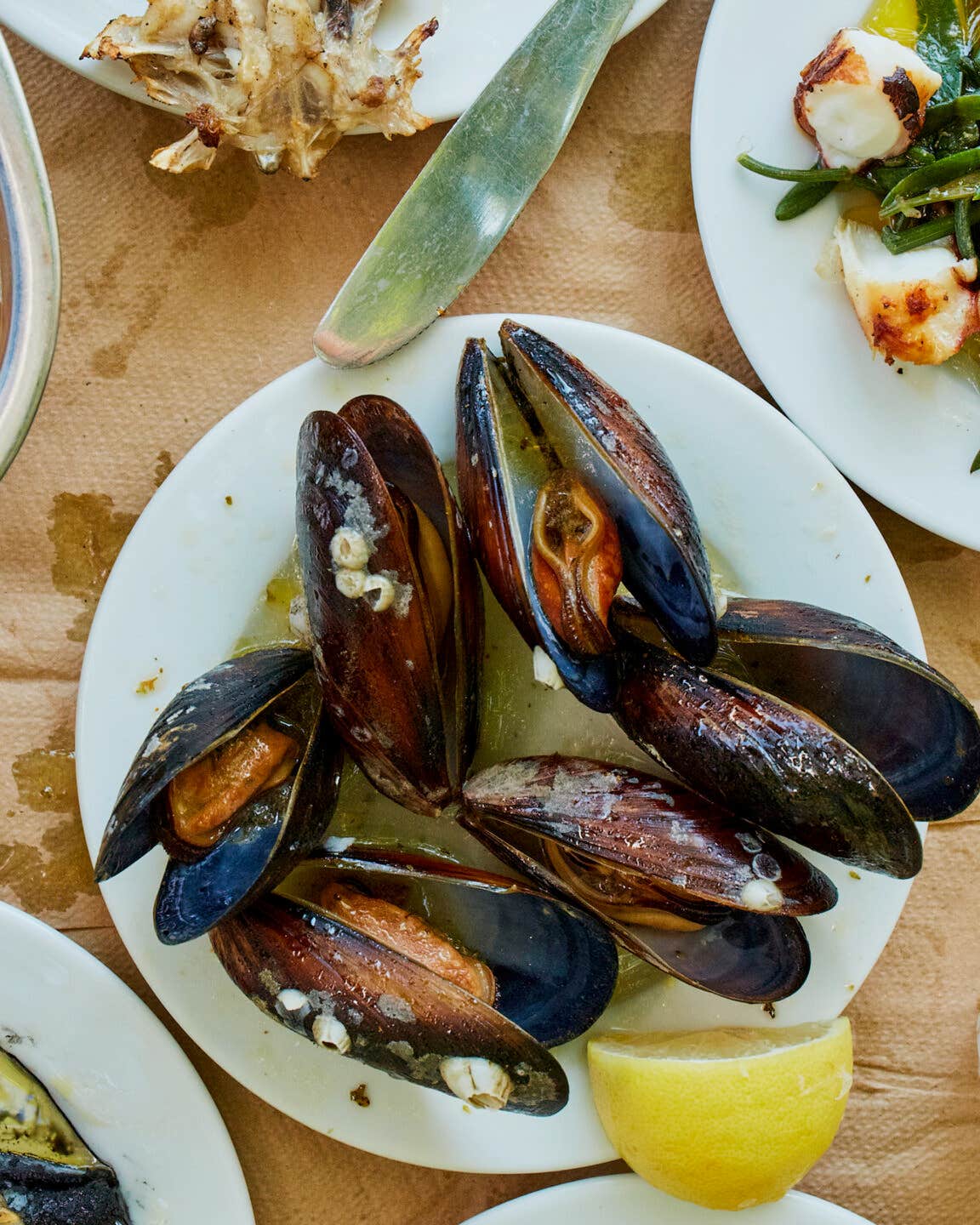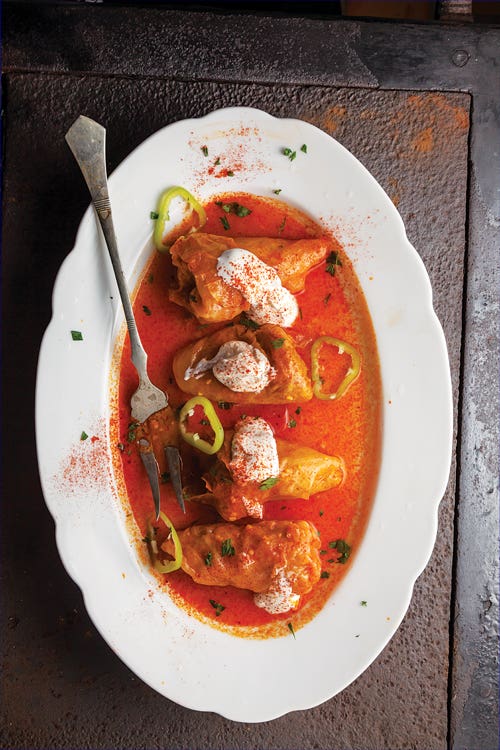
I was standing in my Budapest kitchen amid bright red communist-era cabinets, miniature appliances, and mismatched pots and plates, poring over a recipe for stuffed peppers. It was from a tattered old Hungarian cookbook, the Móra Ferencné Szakácskönyv (Mrs. Ferenc Móra's Cookbook), which I'd bought at a used bookshop in Budapest. I spoke Hungarian pretty well and could read it too—or so I thought.
"We are blanching the peppers," Móra wrote. Wait, how many peppers? For how long? "The stuffing is made in the same way as for stuffed cabbage, but you parboil the rice a little bit." Come again? How much rice? How long is "a little bit"? I did my best to soldier on.
Procuring the ingredients had been simple, a joy even. At the soaring halls of the cathedral-like central market in Budapest I had my pick of different grades of hand-ground paprika in varying shades of red; incredibly fresh local produce; pristine dairy products, from tejföl (the sour cream that is so essential to many Hungarian recipes) to hand-churned butter and raw milk; and richly marbled cuts of pork, much of it from the country's native curly-haired Mangalica pigs.
But despite such exemplary raw material, there I was faced with the desultory results: a pot of wilted peppers and crunchy rice floating in a thin sauce. This was definitely not how it was supposed to look, or taste, though I presented it to my husband Gábor with the best flourish I could muster. It was then, as he bravely struggled to eat it—with images of simmering chicken paprikash, delicate stuffed cabbage, and proper stuffed peppers swirling in my head—that I realized there was only one way I was going to learn how to cook Hungarian food: I had to apprentice myself to the best Hungarian cook I knew. So I picked up the phone and called my mother-in-law.
It had been eight years since I first set foot in Hungary. Gábor and I had met working on a cruise ship in the Caribbean and dated for a few years in the U.S. One summer when he was visiting his family, he invited me to join him. I flew in from Washington, D.C., and Gábor picked me up at the airport. I had arrived right at lunchtime; my stomach rumbled, but he told me not to worry—his mom was making lunch. As we made our way toward Bőny, the little village northwest of Budapest where Gábor was born and raised, I was filled with nervous anticipation. I'd never met his family before, and I knew just a handful of Hungarian words.
Two hours later we pulled up to an elegant old house at the end of a long driveway and were ushered to a table in the garden set under towering horse chestnut and walnut trees. Gábor's mom Kati, a slim woman in her mid-50s, brought out a tray of glasses filled with diólikőr; she'd made the dark brown liqueur with walnuts from the branches that hung above us. I threw back the shot—it was sweet, bitter, and spicy in the back of my throat. It perked up my taste buds.
Kati served the first course, húsleves, whole root vegetables and homemade pasta simmered in a clear consommé. The family passed around a small bowl of hot ground paprika, which each person added to the bowls. I followed suit. The rich soup, laced with smoky heat, worked with the liquor to lift me out of my exhaustion. A succession of platters followed: beef bones, from which we tapped the marrow, spread it on toast, and sprinkled it with salt, black pepper, and more paprika; then a slab of beef braised in red wine; a plate of charcuterie fringed with raw sliced peppers and red onions; glasses of furmint, a white wine that tasted of grapefruit and apricots; cucumbers in a sweet and tangy dressing of sour cream, sugar, and vinegar; and a veritable encyclopedia of pickles. I was getting full, but, wait, there was dessert: szilvás pite, a sheet cake dotted with fresh plums that we chased with strong black coffee. I was full of questions and excitement. What was this delicious world I'd stumbled into?
Exploring the answer to that question has become a life-changing endeavor. A few years after that first visit, I married Gábor and we moved to Budapest where I worked as a journalist. We've been here ever since.
Hungary is a country roughly the size of Indiana, a landlocked place squished between Austria, Slovakia, Romania, Slovenia, Ukraine, Croatia, and Serbia. Because of its location—as well as the complex history of border changes, wars, and occupations in this part of Europe—Hungarians have always heavily shared and borrowed recipes and ingredients: garlic, onions, and pasta arrived when Hungary's King Mátyás married Italy's Beatrice of Naples in the 15th century; paprika, made from ground sun-dried chiles, was introduced when Turks invaded the country in the 16th century. Today the spice is one of the pillars of local cooking. Under Austrian rule in the 18th century, there was a great flowering in Hungarian cookery, from agriculture all the way up to imperial cuisine. It peaked under the Austro-Hungarian empire in the 19th and early 20th centuries, when chefs from France cooking for the court applied refined culinary techniques to traditional Hungarian dishes. This all amounted to a unique and layered cuisine. Things changed, though, in the 20th century, when under communism Hungarian businesses were nationalized and restaurant culture was all but wiped out. But the bones of the cuisine survived in the home-cooked dishes that had been here for centuries—simple, deeply flavored foods built on fat, onions, and paprika—enduring in the kitchens of women who kept culinary traditions alive, passing them down from grandmother to mother to child.
In 2005, when Gábor and I started our own family, we made weekly visits to Kati's house in the countryside, where Kati cooked the same dishes for my children as she had for my husband when he was a child. While I'd eaten in myriad Hungarian restaurants and in the homes of many Hungarian friends, I wanted to dig deeper into the cuisine. Watching my children inhale everything Kati prepared made me want to cook those dishes for them too.
But then I encountered the problem of the indecipherable Hungarian cookbooks, which is how I found myself in Kati's tiny nook of a kitchen one afternoon, not as a guest, but as an apprentice.
Kati didn't offer me formal cooking lessons, but let me ask questions and take notes as she cooked, and I gradually picked up the techniques and recipes that hadn't made their way into Móra's cryptic cookbook. I noticed how, as she made paprikás csirke, chicken simmered in a paprika-spiked sauce, she slowly cooked diced onions in lard and a bit of water until they were translucent, then turned off the heat before quickly stirring in a heap of paprika. "If the paprika burns, it turns bitter," she explained. I saw that she kept a jar of zsèr, a blend of rendered pork fat and cracklings, on hand. She'd dip into that jar to add a smoky, bacony depth to soups, stews, or sauces, or even fold it into the dough for tepertős pogácsa, flaky, savory, yeast-risen rolls that she might stuff with a prune filling. I quickly started a jar of my own at home.
As my cooking improved, I started asking other Hungarian friends if I could watch them cook too, and with every kitchen I visited, the cuisine took on another dimension. It struck me how resourceful their cooking was. In various ways, these home cooks transformed basic ingredients—flour, fat, milk—into extravagant dishes. From Mária Keresztes Kovács, Gábor's sister's mother-in-law, I learned how to thicken soups by whisking rántás, a roux of flour and lard enriched with sour cream, into the soup's base; added to csülkös bableves, a soup of pork and beans, the rántás transforms the rustic dish into something luxurious. From the hands of Edit Szabó Gézáné, a radiant 54-year-old home cook in Kisar whom I knew through a mutual friend, even stuffed cabbage leaves astonished me. She steamed the leaves and used them to create tight conical packages that held a polenta-like cornmeal filling studded with ham and slivers of pepper. Bathed in a bright tomato sauce, the dish was a gorgeous play of flavors. But her simplest dish was my favorite: She braised pork ribs in lard, transforming the rib meat into an unctuous confit, then fried them to create a crisp exterior. Served with sliced sweet peppers and wedges of ripe tomato, it was a dish in perfect balance.
Hungarian Comfort Food
We’re making a meal of robust Hungarian comfort food for a chilly Autumn evening this week, inspired by Carolyn Bánfalvi’s story Rhapsody in Red from Saveur’s October 2013 issue. Rolls enriched with pork cracklings and a thick prune jam complement Hungarian-style stuffed cabbage and classic Chicken Paprikash. After dinner, a cinnamon-sugar dusted plum cake and Diólikőr, a traditional walnut liqueur, satisfy your sweet tooth. See the menu for Hungarian Comfort Food »
Thanks to these women, I now have a small but growing roster of dishes of my own. I'll make chicken paprikash with homemade galuska, little dumplings I form by pushing egg dough through a spätzle plane into boiling water. I make szilvás pite, reveling in the way the tart, juicy ripe plums from the market meld with the tender sheet cake.
But try as I might, Kati's food is still our household's benchmark—more so than ever, in fact. After realizing that she spent more of her time visiting her grandchildren than at her own home, Kati moved to Budapest; she now lives two doors down from us, where she welcomes a steady flow of family members coming to eat. She is guiding the taste of another generation. “It wasn't as good as Nana's,” is often the reply I get when I ask my children how they enjoyed dinner at our house. I don't mind one bit—if I surpassed my mentor, whom would I have to learn from?
Keep Reading
Continue to Next Story
